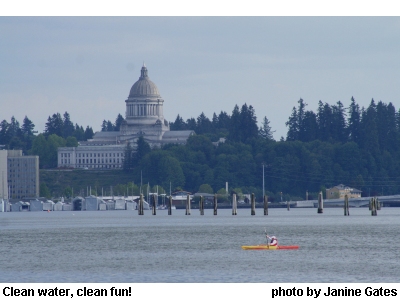Building Green Protects Water Quality and QuantityBy Gabrielle Byrne & Bruce Wishart: People For Puget Sound
People are beginning to realize that the Puget Sound needs help. Despite the sparkling surface and beautiful sunsets, there are real problems with the condition of the water and the habitat that it provides. One of the primary issues facing the community is storm water runoff associated with land development. When development occurs in previously undeveloped areas, the resulting alterations to the land dramatically change how water is transported and stored. Development creates impervious surfaces and compacted soils that filter less water, which increases surface water runoff and decreases groundwater infiltration. With increased storm water runoff, everything works its way down to the water, whether itís the coffee you spill on the sidewalk, the herbicide you use on your lawn or the oil that comes off your driveway. Itís all in there and can even be measured. The connection that people donít make as often involves one of the most important ways of dealing with this problem; looking at pervious versus impervious surfaces. In a nutshell, everything runs off a parking lot, while in a small wood, most everything will filter down through the soil and roots and be much cleaner when it emerges. If we look at the Puget Sound as a whole system like our bodies, natural areas such as the forests and wetlands are our kidneys. These natural areas serve not only as water quality filters, but also recharge groundwater, thereby replenishing underground aquifers used for drinking supplies and adequate stream flows needed by salmon. With increasing populations we need to build in low impact ways that minimize land disturbance and storm water runoff. Throughout the Sound, many cities and developers are exploring ways to develop with less impact. But we must also recognize that leaving some areas alone is an important key to success in cleaning up the Puget Sound and keeping it clean. A few quick facts back this idea up eloquently. For example, forested buffers 164 feet wide filter out approximately 75% of sediment and pollutants. In fact, mature trees absorb up to 50% of rainfall all by themselves! Furthermore, watersheds with 25% impervious surfaces are generally no longer healthy; stream channels can become unstable, and water quality and biological diversity are poor. With the kind of population growth the Sound area is expecting, now is the time to make sure weíre being smart in our land use planning and zoning - not only building in ways that reduce impacts on the land, but also protecting undisturbed natural land. We should consider our watersheds as whole systems that provide multiple benefits; protecting our health, our food, fish and wildlife, and the beauty and diversity of the place we all call home.
Back to Home page. |

